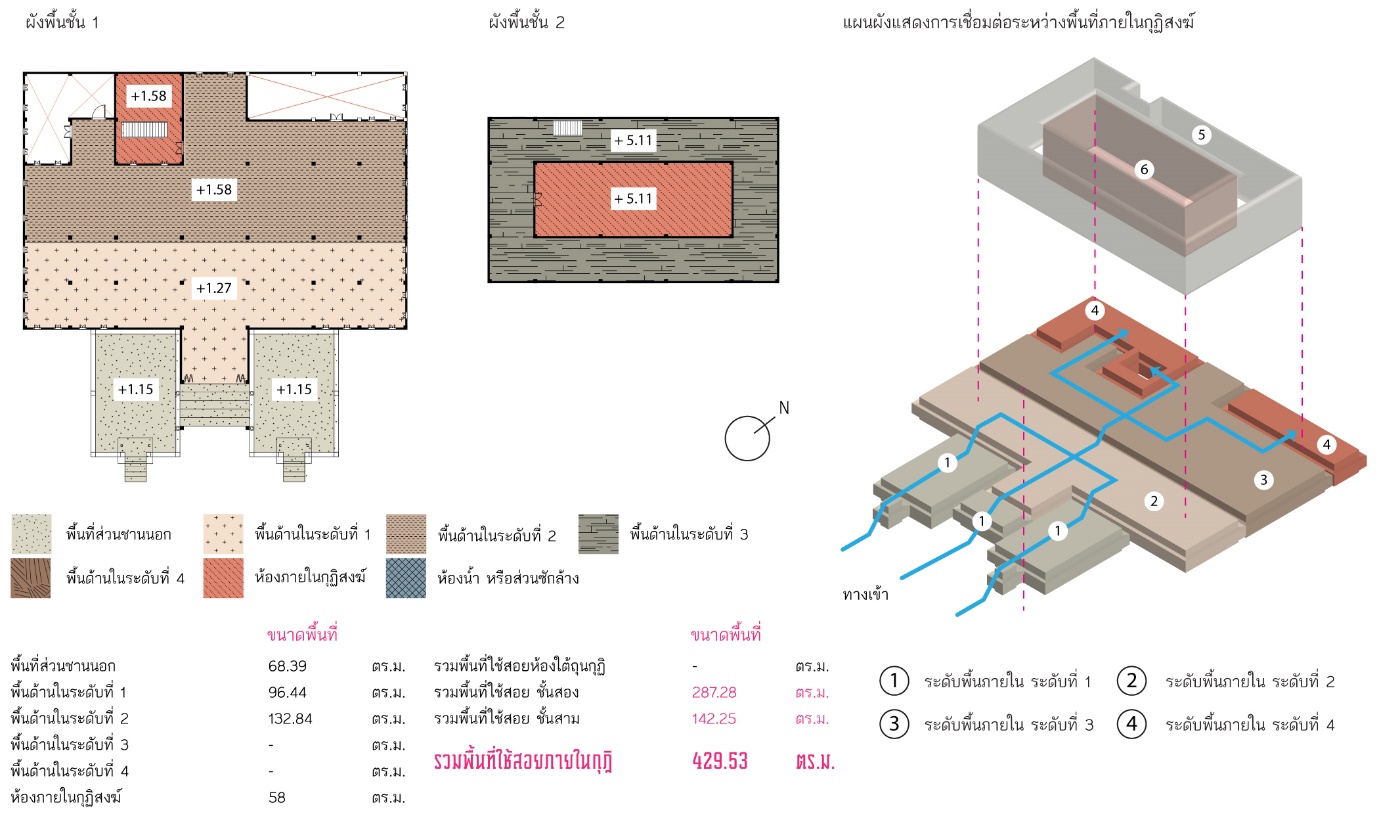Southern Buddhist Monasteries: Typology of Buddhist Monasteries Architectures in Takbai, Narathiwas Province and the Observations on Function and Architectural Configuration in Local Society and Culture Context
Main Article Content
Abstract
For the study, it focuses on analyzing “Floor space planning” and “Typology of Architectures” of the largest monk cells (a.k.a. “Kuti”) in Buddhist monasteries that are in Buddhist Communities at Takbai, Narathiwas Province, Thailand. According to the fieldwork survey, 3 of 4 Kuti-abbot’s dwelling from Wat Chonthara Singhe and 1 of 4 from Wat Kok Ma Feuang were chosen to study. However, the largest monastic cell in Buddhist monasteries are different from the traditional Buddhist Monasteries in Songkhla Lake Basin which also has strong relationship with Buddhism organization in Chaopraya Basin and Theravada Buddhism in Central of Thailand. The research shows that they have specific and significant characters, such as the typology, the floor space planning, integrated multipurpose area, “Sala rongtham”, attic, wood carving and ventilation panel.
Downloads
Article Details

This work is licensed under a Creative Commons Attribution-NonCommercial-NoDerivatives 4.0 International License.
All material is licensed under the terms of the Creative Commons Attribution 4.0 International (CC-BY-NC-ND 4.0) License, unless otherwise stated. As such, authors are free to share, copy, and redistribute the material in any medium or format. The authors must give appropriate credit, provide a link to the license, and indicate if changes were made. The authors may do so in any reasonable manner, but not in any way that suggests the licensor endorses you or your use. The authors may not use the material for commercial purposes. If the authors remix, transform, or build upon the material, they may not distribute the modified material, unless permission is obtained from JARS. Final, accepted versions of the paper may be posted on third party repositories, provided appropriate acknowledgement to the original source is clearly noted.
References
Brown, J. M. (1985). From ancient Thai to modern dialects. From ancient Thai to modern dialects and other writing on historical Thai linguistics. Bangkok: White Lotus.
Buranaut, I., & Kirdsiri, K. (2014). Buddhism vernacular architecture in Songkhla Lake Basin. Journal of Architectural Research and Studies (JARS), 11(1), 1-20.
Buranaut, I., & Seneevong Na Ayudhaya, K. (2014). A Study on the explicit knowledge and local wisdom in the field of housing for knowledge management in the south of Thailand research program. NAJUA | Architecture, Design and Built Environment, 28, 199-235.
Gedney, W. J. (1965). Review of J Mavin Brown: From ancient Thai to modern dialects. Scientific Studies of Reading (SSR), 3(2), 107-112.
Jirathut, S. (2002). Wat: Phut tha sasona sa tha pat ta ya kam thai. Bangkok: Thammasat Press.
Khoruamdach, B. (2012). The orditional hall (Ubosot) in Thai temples in Malaya (Kelentan Kedah Perlis and Penang) Rattanakosin period. (Doctoral dissertation). Silpakorn University, Department of Art History.
Khongsak, S. (2011). Nakhon Si Thammarat in Fernand Mendez Pinto letter 1543 and Pattani and Nakhon Si Thammarat in french encyclopedia. In 100 Ekkasan samkhan: sapphasara prawattisat, Vol. 12. Bangkok: The Thailand Research Fund (TRF).
Kitprasert, C. (1985). A tonal comparison of Tai Dialects: Tak Bai Group. Naokorn Pathom: Mahidol University.
National Office of Buddhism. (2017). Buddhism temple registration report. Narathiwat: Author.
Na Songkhla, W. (1990). Mural painting in Thailand, Vol. 2, No. 3 Wat Chon Thara Singhe. Bangkok: Office of Archaeology the Fine Arts Department.
Phra Payutto, P. A. (2006). Ja-rik-boon-ja-ruek-dhamma. Bangkok: Pim Sua.
Phra Payutto, P. A. (2015). DHUTANGA: What to Do? Where? What for?. Bangkok: Active Print.
Pichard, P. (2013). Indian buddhist monasteries. In P. Pichard, & F. Lagirade (Eds.), The buddhist monastery (pp. 17-37). Bangkok: Silkworm.
Pichard, P. (2013). The Thai Monastery. In P. Pichard, & F. Lagirade (Eds.), The buddhist monastery (pp. 98-118). Bangkok: Silkworm.
Potibal, P., & Trongdee, T. (1998). The position of Tak Bai in Tai dialects. In S. Burusphat (Ed.), The International Conference on Tai Studies (pp. 313-322). Bangkok, Thailand: Mahidol University.
Punyanupab, S. (1979). Tipitaka for the common. (4th ed.). Bangkok: Mahamakut Buddhist University.
Rajanubhab, D. (1970). Tam nan phra phut tha chedi. Bangkok: Sinlapabannakhan.
Rajanubhab, D. (2003). Chot mai het raya thang ratchathut langka khao ma kho phra song sa yam. In Rueang pradit sathan phra song sa yam wong nai lang ka tha wip (pp. 138-140). Bangkok: Silapawattanatham.
Suwannarat, J. (2004). Style and concept of Kuti’s mural paintings in Pattani and Narathiwat. (Master’s thesis). Silpakorn University, Department of Art History.
Vajirananavarorasa. (1998). Buddha Prawat. Bangkok: Mahamakut Buddhist University.


